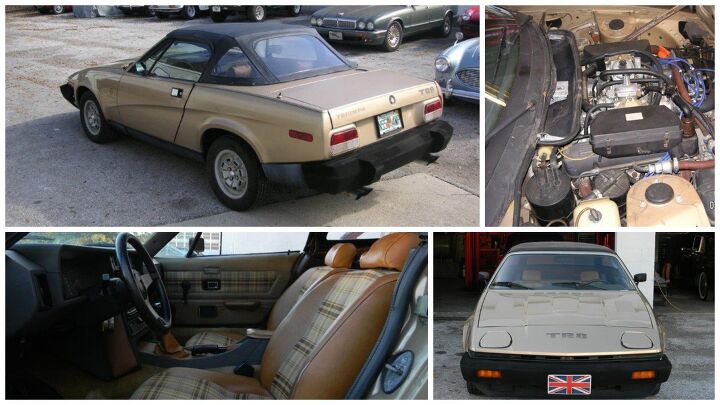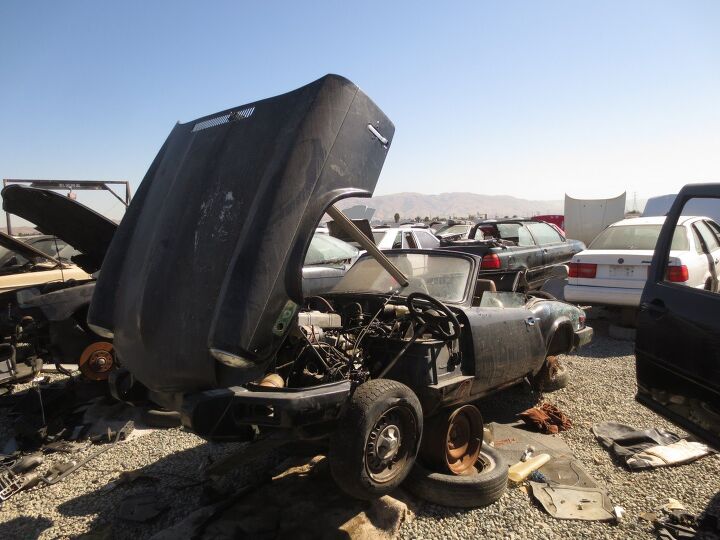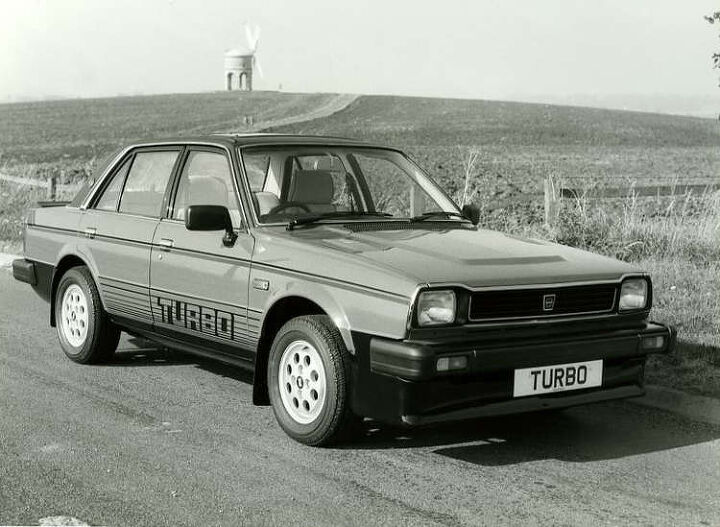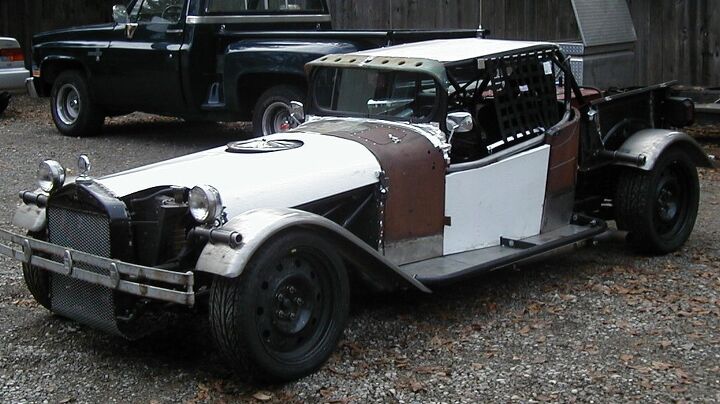#Triumph
Junkyard Find: 1976 Triumph TR7 Victory Edition
I’ve been visiting car graveyards since I bought my first hooptie for 50 bucks in the early 1980s, and one thing about American junkyards has remained constant during the following four decades: the presence of 1970s British and Italian sports cars. Maybe they were a bit less weathered in 1987 or 1994 or 2006, but a steady trickle of discarded MGBs, 124 Sport Spiders, X1/9s, Jensen-Healeys, Spitfires, Midgets, and TR7s into U-Wrench yards has flowed at about the same rate throughout. That’s why I wasn’t surprised to discover this allegedly rare 1976 Triumph TR7 Victory Edition in a Denver-area yard last month.
Rare Rides: A 1981 Triumph TR8 That's Both Beige and Brand New
You read the title correctly. There’s a Triumph TR8 for sale in the urbane and international city of Tampa, which is in Florida. Miraculously, the sporty convertible has traveled just 90 miles since 1981.
It’s beige, malaise, and showroom fresh, so let’s have a look.
Rare Rides: Behold the 1969 Marcos GT, a Story of Continual Collapse
Struggling for decades, Marcos Engineering produced very few examples of its flagship GT model. This excellent condition restored example recently made its way up onto the eBay auction block, which presents a good opportunity to take a look at this stylish British sports car.
Digestible Collectible: 1980 Triumph TR8
As I was born in late 1978, I’m a bit young to recall the Malaise era. One of my earliest memories in life is of John Hinckley’s assassination attempt on President Reagan, so most recollections I have of the cars of the time were on used car lots and, just as often, with the hood up roadside.
Of course, the British car industry was imploding around this time. Very few new models were introduced; most cars were rehashed, smogged versions of the cars British Leyland had been building for many years.
In the Triumph TR7 and later TR8, they did manage to bring a clean-sheet design to U.S. showrooms.
Piston Slap: A Triumph Over A Sticky Clutch?
TTAC commentator krhodes1 writes:
Hi Sajeev,
Here is one for you and the B&B: ’74 (more or less) Triumph Spitfire with a clutch issue. The clutch feels “sticky”, doesn’t release smoothly, and makes starting off in first a little challenging. Otherwise, the clutch works fine once you are moving.
Crapwagon Poll: 1978 MGB Vs. Triumph TR7
Today, I’m asking the readers to look at a couple underappreciated classics. I’m lumping them under the Crapwagon banner, as they are relatively unloved developments of some special British roadsters.
As I’ve mentioned before, I’m a child of the Eighties, so hot hatches and poster-style supercars certainly appeal to me. However, like many gearheads, my dad influenced my automotive wanderlust. Dad was into Datsun Z-cars as well as the MGB. There was rarely a time in my young life when the garage didn’t hold at least one of these paragons of Nixon-era cheap performance. I never got to drive Dad’s last MG, though, as he sold it (after I helped him restore it) when I was about fifteen.
Piston Slap: A Silver Arrow Through the Heart?
TTAC commentator confused1096 writes:
Sajeev, I need some insight and good advice from yourself and the B & B. Here’s the problem: After my wife’s back surgery we no longer use my ’99 Buick Riviera Silver Arrow (#120) since it’s not comfortable for her to sit in (too low down, shape of seat etc.).
Junkyard Find: 1979 Triumph Spitfire 1500
The low-value British or Italian sports car that sits in rough condition in a yard or driveway for decades, then takes that sad final journey to the local U-Wrench-It— it’s been a staple of the American self-service wrecking yard landscape for what seems like forever. The MGB and Fiat 124 Sport Spider are by far the most common examples of this breed, followed by the TR7, Alfa Romeo Spider, and the Triumph Spitfire. So far in this series, we’ve seen this ’65, this ’67, and this ’75, and now we’re getting right to the end of the Spitfire’s 19-year production run with today’s ’79.
Crapwagon Outtake: Honda's Turbo Triumph
Honda is gearing up to launch the all-new, turbocharged Civic Type-R, but they’ve actually made a boosted Civic before. And it was badged as a Triumph. The last Triumph ever, in fact.
Junkyard Find: 1967 Triumph Spitfire Mark III
Some old cars have managed to maintain a steady trickle of fresh examples into self-serve wrecking yards since I began crawling around in such yards, back in 1981 or so. The kings of this phenomenon are, of course, the Fiat 124 Sport Spider (in a few years of this series we’ve seen this ’71, this ’73, this ’75, this ’78, and this ’80), and the MGB (so far, this ’67, this ’71, this ’75, this ’79, and this ’79 with Toyota 20R power). The MGB’s British Leyland cousin, the Triumph Spitfire, has been a rarer but just-as-steady find for me; first this ’65 and then this ’75, and the prehistory of this series gives us this Spitfire-sibling ’67 GT6 as well. What these cars have in common is near-scrap value when in rough shape, respectable price tags when in nice condition, and a tendency to be hoarded by guys who plan— someday— to turn the former condition into the latter condition. Eventually, reality sets in and a car that sat in a driveway from the time of the Chowchilla Kidnapping until a few months ago takes its final trip. Here’s a rust-free, fairly complete, restorable early-ish Spitfire that I saw last month in a Northern California yard.
Junkyard Find: 1965 Triumph Spitfire
By far the most numerous British sports car in junkyards these days— and, in fact, for the last few decades— is the MGB. We’ve seen many of these cars in this series, but today’s find is just the second Junkyard Find Spitfire, after this ’75. The Spitfire had a long production run, 19 years total, but Spitfires just weren’t anywhere near as sturdy as their MGB cousins and most of the non-perfect examples got crushed long ago. Still, every so often a forgotten project gets evicted from a garage or back yard, and that’s probably what this happened to this battered ’65 that I spotted in a San Francisco Bay Area self-service yard last month.
Junkyard Find: 1980 Triumph TR7 With V8 V6 Swap
We’ve seen a couple of “poor man’s TR8” race cars in the 24 Hours of LeMons: you take a TR7 and drop a junkyard V8 out of a junked Land Rover into it. This works better than both the “really poor man’s TR8″ (a TR7 with Buick V6 swap), in the sense that it sounds a lot cooler, and is (slightly) more reliable than a Triumph Slant Four-powered TR7. Plenty of folks did this swap to their street TR7s as well, and I’ve found an example in a Denver self-service wrecking yard.
Junkyard Find: 1975 Triumph Spitfire
A less-than-perfect Spitfire, like the MGB, typically spends a decade or three as a get-around-to-it-someday project car under a tarp in the driveway… and then it’s off to the junkyard when reality finally sinks in. I haven’t seen a beater Spitfire for at least a decade now, so this is one of many smoked out of its hiding place by high scrap-steel prices.
Quattroporte, Stretch Limo, Model T, and More: The Greatest Gathering of LeMons Cars In History!
With nearly 180 entries, the 2010 Arse Freeze-a-Palooza will be the biggest 24 Hours of LeMons race in history, and it also promises to have the highest concentration of never-belonged-on-a-road-course awesome machinery ever gathered in one location. At this moment, I’m wearing the LeMons Supreme Court judicial robes and busting cheaters, which means that I’m finally allowed to share some of these fine machines with you and not ruin their grand entrances at the track.
Piston Slap: TR4 Compression Depression...Or Not?
Ken Dowd writes:
I’ve got high compression readings of over 190 lbs on all cyls on my TR4. The head has been reworked twice that I know of, about .050 has been shaved. I got these readings after putting the engine back together with all new sleeves, pistons, rings and a head/valve job. I CCed. the head at 55cc and crunched the numbers on several online compression ratio calculators and figured my compression to be about 9.5:1 Compression ratio on the stock engine is 9:1. Would you expect to see such high compression readings with such a small increase in compression ratio?
I’ve searched the world over and cannot find a spec for compression on a healthy 2138cc TR4 engine. Do you have any experience with after market solid copper oversized (thicker) head gaskets to bring down compression? That is the only thing I can come up with. Your thoughts would be appreciated.






























Recent Comments